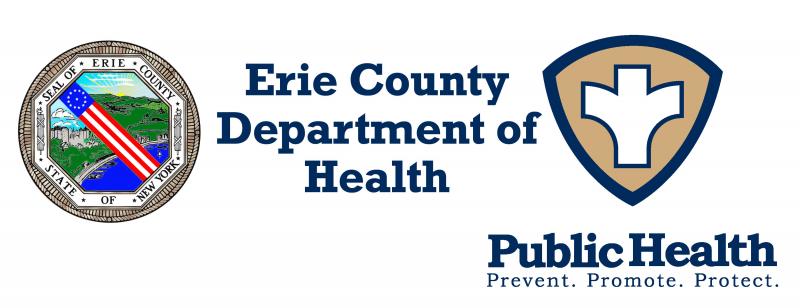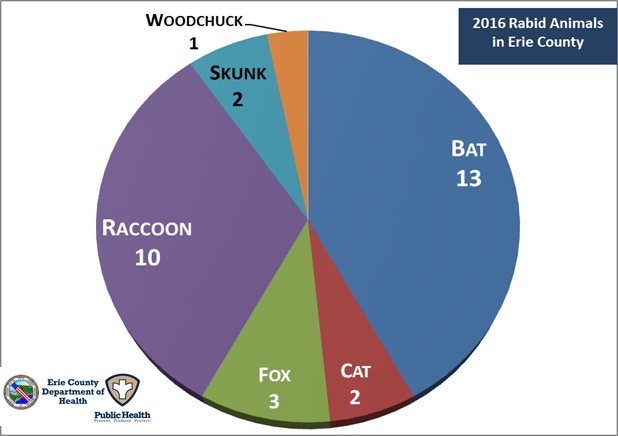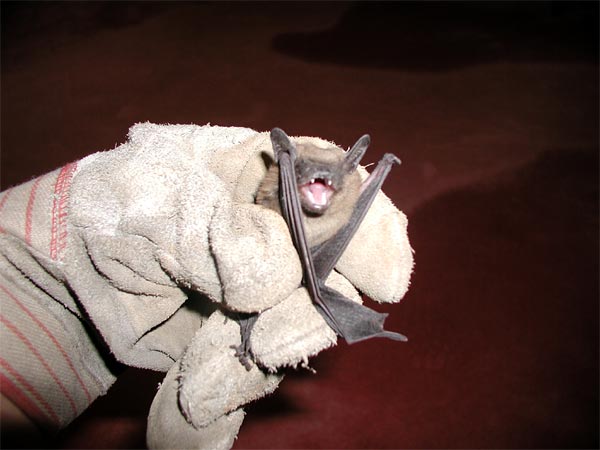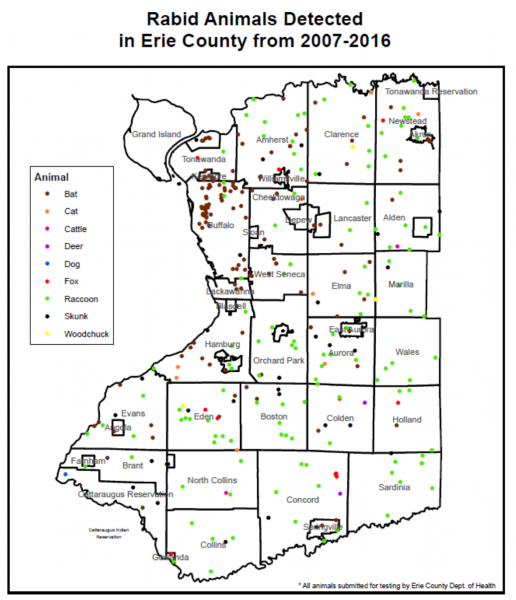Modified: June 8, 2017 3:57pm
Latest News

PRESS RELEASE
From the Office of the Commissioner of Health, Dr. Gale R. Burstein
June 8, 2017
Contact: Mary C. St. Mary / Mary.StMary@Erie.Gov
Phone: (716) 858-4941 / Mobile: (716)253-3925
Warm Weather Rabies Precautions
Do NOT Touch Wildlife—For Your Sake & Theirs
ERIE COUNTY, NY — Warmer days are here, and with everyone spending more time outdoors, there is an increased likelihood of encountering a wild animal. Unfortunately, it is also the most likely time of year to encounter a rabid wild animal or to be bitten by a bat that has made its way inside your home.
As the 2016-2017 winter was quite mild, more wildlife and insects survived than usual. A significant number of abandoned raccoon and fox pups have already been reported, along with both pups and mothers testing positive for rabies.
Very often well intentioned individuals attempt to help young wildlife that appears to be orphaned. However, the best thing to do is leave wildlife alone. Handling these animals may result in them inadvertently being euthanized and anyone who handled them would need to undergo post-exposure anti-rabies vaccinations, as they may have exposed themselves and any close connections to rabies.
In addition, if your pet is involved with a suspected rabid animal, do not handle the dog with bare hands following the incident. There is the possibility of getting your pet’s saliva on your hands. Wait a few hours and then bathe the animal while wearing protective gloves.
If an animal is obviously injured and/or orphaned, call a wildlife rehabilitator for advice and help, such as the Wildlife Department of the SPCA serving Erie County (716-875-7360) or the New York State Department of Environmental Conservation’s (“DEC”) Regional Wildlife office to locate a wildlife rehabilitator in your area (716- 851-7010). Do not handle wildlife! Handling wildlife places both your life and their lives at risk.
In addition to young wildlife possibly carrying the Rabies virus, all of the many species of bats that live in Erie County can carry rabies. Rabid bats frequently lose their ability to fly, and may be found on the ground or in water, making them more likely to come into contact with people or pets. A healthy bat typically avoids any contact with humans/animals and will not be found resting on the ground. Bats with rabies are often disoriented, increasing the likelihood that they end up inside a dwelling by accident.
“Rabies is transmitted when an infected animal bites or scratches a person's skin,” said Erie County Health Commissioner Dr. Gale Burstein. “Even a minor scratch or simply touching an animal may be enough to transmit the rabies virus from animal to human. Bat bites may not be noticed because bat teeth are very tiny and razor sharp and a bat bite can be no bigger than a needle prick. Rabies infected wildlife, such as raccoons, carry rabies and transmit infection, without necessarily a bite. ANY direct contact with a bat or other potentially rabies infected wildlife should be considered a possible rabies exposure. Erie County residents should contact Erie County Department of Health (“ECDOH”) for questions about possible rabies exposure. Since rabies is nearly always fatal, it is important to take aggressive precautions to prevent the development of disease.”

“Bats should be captured if there has been direct contact with a person or pet, or if the bat was found in the vicinity of someone who might have been exposed. Once the bat is captured, they need to be tested for rabies infection,” stated Peter Tripi, Senior Public Health Sanitarian. “Do not release a live bat or throw out a dead bat that has bitten or scratched, or had direct contact with a person or pet, unless the ECDOH has told you that it will not be necessary to test the bat. Do not injure the bat’s brain as that is needed to test for the rabies virus.” If someone wakes up to find a bat in the room, or a bat is found in the room of an unattended small child, an intoxicated or mentally incapacitated person, or a family pet, the possibility exists that a bat bite, scratch -- or direct contact -- may have occurred.
Suggestions to safely capture a bat:
- Never handle a bat with bare hands. Wear thick gloves to pick up a dead or injured bat or pick up the bat with a shovel or dust pan.
- For a live bat, wait until the bat has landed. Place an empty can or wastebasket over the bat and slide cardboard underneath to contain the bat.
- If the bat is still flying, try gently striking it with a broom or tennis racket in order to knock it down. You can also try to capture it in a net.
- Use heavy gloves (like leather work gloves) to place the bat in a sealed can or jar, or place it in a plastic bag that is within another heavy-weight plastic bag such as a zip-lock bag.For a live bat, punch small holes (less than ½ inch in diameter) in the container(s) for the bat to breathe. Place the container in a quiet area away from heavy human traffic. Do not refrigerate, freeze or kill a live bat.
- Dead bats that will be sent to a laboratory for testing should be refrigerated (not frozen) until the laboratory can begin testing. Do not refrigerate, freeze or kill a live bat.
In 2016, there were 31 rabid animals identified in Erie County, with 13 rabid bats and 10 raccoons. To date in 2017, there have been 4 confirmed rabid animals in Erie County, including 1 sheep, which is highly unusual. Livestock are also susceptible to rabies and need to be vaccinated against the virus to avoid the significant economic loss should the animal die of rabies. Any other animals that live on your property, such as barn cats, should be vaccinated against rabies.
Attachment: Map of Rabid Animals in Erie County 2007-2016 by Species

For more information:
Erie County Department of Health—Bats
Erie County Department of Health--Rabies
Centers for Disease Control and Prevention

